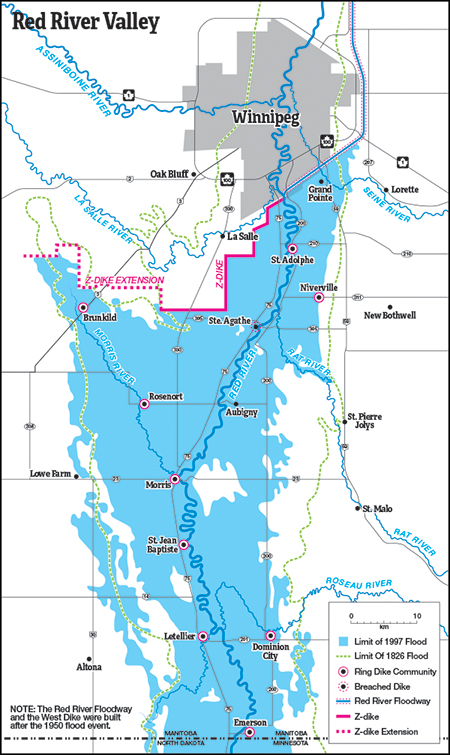
Fortunately, the 2019 Red River Flood has turned out to be a relatively non-event, with the crest this week falling well short of the dire predictions made earlier in the year before an unusually cool and dry spring came to the rescue. Although water levels on the river are currently very high, they are not threatening very many towns and homes. However, that was not always the case. Today’s article, originally published two years ago, examines some of the more momentous springs in the Red River Valley in recent memory.
When you’re talking about spring flooding in our part of the world, the year 1997 jumps to the forefront of any conversation. But while that flood was historic, it’s hardly the only time rising waters have put our region in peril. In fact, a number of other floods could easily lay claim to being the biggest or most dangerous of their respective eras.
If you ask anybody old enough to remember, they’ll likely make a case for the flood of 1950 as being the true flood of the century. Heavy winter snow and spring rains swelled the Red to the point that dikes could no longer keep the waters out of Winnipeg. The result was 100,000 people being evacuated from their homes and businesses, resulting in nearly a billion dollars’ worth of damage in today’s dollars. Outside the city, 550 square miles of the Red River Valley was flooded. The government declared a state of emergency and the Army and Red Cross were called in to help with relief efforts.
The 1950 flood prompted the Government of Manitoba to build the Red River Floodway, a project of considerable hand-wringing, which to this day protects Winnipeg from the river while occasionally causing headaches for people outside the Perimeter Highway.
Want to go back even further? How about 1826? Nearly 200 years ago, there were no government flood officials to call annual press conferences to keep the local settlers up to date on the latest flood forecasts. So when the Red broke its banks that May, settlers were caught by surprise and sent scrambling.
One source, from a settler writing in 1856, reads, “Hardly a house or building of any kind was left standing in the colony. Many of the buildings drifted along whole and entire; and in some were seen dogs, howling dismally, and cats, that jumped frantically from side to side of their precarious abodes. The most singular spectacle was a house in flames, drifting along in the night, its one half immersed in water, and the remainder furiously burning. This accident was caused by the hasty retreat of the occupiers. The water continued rising… and extended far over the plains; where cattle used to graze, boats were now plying under full sail.”1
Of course, accurate data relating to exact damage and property loss in 1826 is impossible to find, but it can certainly be said that the flood of 1826 changed the course of our province. The flood caused the population to be redistributed throughout the Red River Valley.
Though flooding has continued to take place intermittently in our region—1852, 1974, and 1979 all saw significant flooding—most of us today will remember best and identify most with the floods of 2009 and 2011. For many transplanted city folk at the forefront of the housing boom in Niverville and Ritchot, this was the first real flooding we had seen without the reassurance of the floodway to protect our property. As waters closed in around towns and roads in the region, worries and wonderment rose.
The 2009 flood was caused by the usual mixture of winter snow and spring precipitation, but with a heavy November rainfall thrown in after the ground had already frozen. In the end, the river crested just two feet lower than in 1997.
In 2011, initial worries were centred on the possibility of both the Red and Assiniboine Rivers cresting at the same time. Eventually the most severe flooding took place west of us, and another state of emergency was called as the Assiniboine reached its highest levels ever recorded at Brandon.
Flooding in 2011 was particularly agonizing for the Niverville community, as local resident Raymond Stott drowned after his truck was swept away by floodwaters.



















